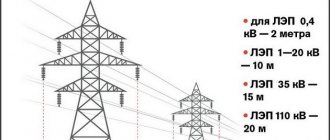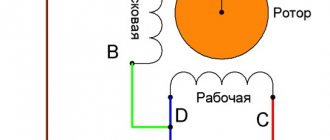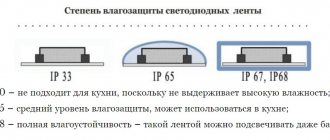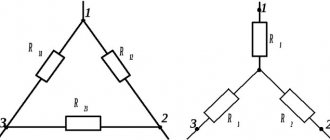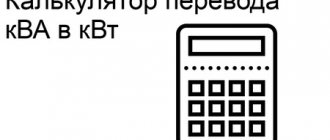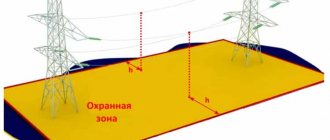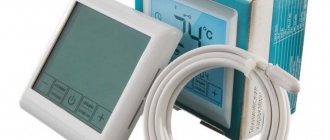SIP suspension
Re-grounding installation
0.4 kV overhead power lines are installed from 10/0.4 kV transformer substations to the consumer and consist of 4 insulated SIP wires (3 phases). The length of the overhead line must comply with the specifications for voltage quality, uninterrupted power supply, and economic indicators. An automatic device is installed at the consumer input to limit power consumption.
The experience of using 0.4 kV power lines with bare wire has proven their unsafety. This is due to the likelihood of electric shock when the overhead line breaks. Difficult weather conditions cause frequent short circuits of the exposed wire. To avoid these problems, a new type of wire was developed - SIP (self-supporting insulated wire).
Types of SIP for overhead lines
The SIP wire is made of aluminum conductors, separately coated with UV-resistant insulation. Several types are used for VLI:
- SIP – 1 – self-supporting wire with aluminum conductors, insulated from light-stabilized cross-linked polyethylene (PE), with a zero load-bearing uninsulated conductor made of aluminum alloy;
- SIP – 2 – self-supporting wire with aluminum cores, insulated with light-stabilized cross-linked polyethylene, with a zero load-bearing core, made of aluminum alloy, insulated with light-stabilized cross-linked PE.
- SIP – 3 – self-supporting protected wire with a current-carrying core made of aluminum alloy, with protective insulation made of light-stabilized cross-linked PE.
- SIP – 4 – self-supporting insulated wire without a supporting element, with aluminum conductors, with insulation made of light-stabilized cross-linked PE. If there is a water blocking element, the letter “g” is added to the wire grade.
- SIP - 5 - all cores have an insulating cover made of cross-linked light-stabilized polyethylene (polyethylene with cross-linked molecular bonds). The wire may consist of 2 or more cores. In the design of the SIP-5 wire there is no separate load-bearing core.
Schemes of power supply networks 10(6) kV
An example of a power supply diagram for powering a special group of electrical receivers. Cable jumpers and the power of the third emergency source are selected based on the load of the receivers of a special group, intended only for trouble-free shutdown of production. The pass-through substation is included in the cutting of one or two lines with double-sided or one-sided power supply.
Power supply to distribution points is carried out according to radial circuits from different sections of 10 6 kV buses of support substations or deep input substations or from different substations. The disadvantages of the considered scheme are: disconnection of short circuits on the line by two switches, which increases the total number of switch revisions; increased cost of switchgear design with an odd number of connections, since one circuit must be connected through two switches; reduced reliability of the circuit if the number of lines does not correspond to the number of transformers.
Electrical circuit diagram Outgoing line to TSN Page 3 of 4 Schemes of supply electrical networks 10 6 kV The purpose of supply electrical networks is concentrated power transmission to areas remote from deep input substations and support substations.
A jumper of two disconnectors is used when disconnecting lines. Along with its advantages, a scheme with one non-sectional bus system has a number of disadvantages.
In normal operation, one of the jumper disconnects should be disabled. Based on the degree of reliability of power supply, main circuits can be divided into two main groups. Schemes 15, 16 and 17, when the number of lines is more than 4, as well as according to the conditions for maintaining the stability of the power system, are checked for the need to section the busbars. A more complex scheme also contains one partitioned bus system, but it adds a bypass bus system (Fig.
Directions for using quadrilateral and hexagon patterns. What are star and delta in a transformer?
See also: How to measure a loop phase phase
Construction of overhead lines
A trained team is allowed to carry out construction. All electrical installation work is carried out according to standard maps, or according to a project developed and agreed upon with the customer. Construction work includes:
- Development of pits and installation of supports;
- Installation of wires and grounding devices.
At the beginning of the work, the route is cleared for installing supports and rolling out the wire. If the construction of an overhead line is carried out on an old route, then the old supports are first dismantled. The SIP wire is rolled out along the installed new supports so as not to damage the insulation. A team of electricians lifts the wire onto the supports and installs fittings and grounding devices.
Security zone distances
Whatever the distance around the supports according to the law (for example, the security zone of a 10 kV power line requires 10 m on each side), the norms for distances from the supports must still be observed. The installation must perform its functions without threatening anyone’s life or health.
Near the power plant
The main document on the placement of power lines, the procedure for their installation and determining how many meters in each direction need to be retreated when creating security zones is Resolution No. 169, adopted on February 24, 2009 “On the procedure for installing security zones.”
This document is the fundamental Government Decree on the development and placement of power lines, the construction of power lines and the creation of proper boundaries - in the official zone, for which a special legal definition has been developed.
The location of switchgears and points, transformer substations according to regulations is carried out in special buildings and structures that are constantly closed. Departmental instructions provide for the procedure for access of specialists with clearance and authority, and also prohibit access by outsiders.
Diagram of sanitary zones for power lines in accordance with SanPiN standards
It is impossible to build special premises for hundreds of kilometers of overhead power lines, and they are cheaper than laying underground cables, although they remain accessible not only to those who are legally responsible for their condition and operation.
Responsibility for the correct use of power lines rests with those involved in electrical networks.
They are responsible not only for repairs and security, but also for limiting the security zone of power lines. Their responsibilities also include informing the public about the degree of danger and standards for preventing possible consequences.
Supports near the village
Security measures are as follows:
- In determining how many meters is the minimum distance from a power line to a residential building, industrial building, public or domestic building. Reducing it is prohibited by law, and a violation of the prohibition is subject to administrative sanctions under the Code of Administrative Offences.
- Allocation of a plot of land of a certain size in the security zone of a power transmission line, along a vertical plane from the wires. Approaching the earth boundary can be permitted or prohibited only if it is set depending on the number of volts in the overhead line (OHL).
- When structures with wires are located on the water surface, the determination of the permissible distance is also the minimum distance determined by the operating rules.
- When located underground or underwater, it carries out a designation that depends not only on the voltage, but also on the navigability or non-navigability of the reservoir.
- Special clearings are being cut down in forests, shelterbelts and parks. In this case, cutting down each tree carries additional measures to ensure fire safety in the power transmission line security zone and prevent environmental vandalism in the event of a fire.
Table of norms, how many meters you need to retreat in each direction
The work of organizations responsible for safe production or living in places where power lines pass includes the need to place warning signs. Each of them should be durable and bright, reaching a size of 28x21 cm, in case someone has poor eyesight.
Load of overhead lines with SIP wires
Wires insulated with thermoplastic polyethylene are allowed for long-term heating up to 70°C, and short-term heating during short circuit up to 130°C. Wires insulated with cross-linked polyethylene should not exceed the temperature of long-term heating more than 90°C and short-term heating - 250°C, when shorted. The duration of the load on the wire depends on its cross-section and ambient temperature. Every year, according to the schedule, the load on isolated overhead lines is measured and the results are recorded in the overhead line passport.
Grounding of overhead lines
To ensure safety, uninterrupted operation and protection from lightning, the 0 kV power line must be grounded.
Lightning protection grounding is installed every 120 m on supports, as well as:
- on a support with entry into a room where a large number of people live or have agricultural value;
- on the final support with an inlet branch;
- on a support installed 50m from the end of the line;
- on a support with the intersection of high voltage lines.
Grounding is carried out on all metal structures, switchboards, and street lamps.
For the manufacture of grounding, a wire with a diameter of 6 mm with an anti-corrosion coating is used.
Human activities in the protected zone
GOST 12.1.051-90 is the main document with which distances need to be coordinated. It provides a generally accepted definition of a security zone. The list of prohibitions covers various situations in which human activity cannot be carried out.
Prohibition on work
For example, when it comes to the distance of a power transmission line from private property, the security zone of a 0.4 kV overhead line is 2 m from each wire (RF Government Decree No. 160), if we are talking about the boundaries of the site, and not about the foundation of the building. Free space around the electrical installation is necessary in order to avoid the destructive effects of the electromagnetic field.
It has long been proven that the higher the tension, the more significant the negative changes in the human body.
In populated areas there are strictly permitted concepts for security zones depending on voltage. If the security zone of the power line is 35 kV, then a retreat of 15 m is required. At the same time, no trees or bushes can be planted, and in case of violation they will be cut down without fail.
If the power line is located on private land, the owner can use the soil to grow plants. But for this you need to obtain permission from the organization responsible for operating the power line. In this area you cannot plant trees and shrubs, apply fertilizers containing chemical compounds dangerous to the structure, or even water your garden. In this case, the easement on the land property is observed.
The photo shows power line poles.
In the city
Subtleties
The security zone of a 110 kV power line is 20 m, and if over 150 kV, then 25 m. It should be noted that even agreement with the relevant authority does not give the direct owner of the site the right to restrict access for repairs. It will not be possible to prevent repairs if necessary on the grounds that it is land property and crops are grown on it.
Minimum indentation standards
The basic rule is to follow the prescribed order:
- You cannot block entrances and roads, dump garbage and snow, or keep animals;
- interfere with the work of people who need repairs and have permission to carry them out;
- no construction, dismantling, improvement or reconstruction of buildings is permitted until a permit to demolish, begin construction or carry out demolition has been issued;
- another condition is the absence of any excavation work near power lines, land reclamation or the use of explosions, even with the most urgent need to lay irrigation canals, ditches for pipes or cables.
Power Line Support Options
All these actions, in the absence of a work permit from the owner of the site (unless he removes the obstacles he himself created), may entail an administrative fine or filing a lawsuit in court. And the judicial authority always regards such actions as creating a danger or threat to the operation of a high-voltage or cable line, which is an administrative violation.
Acceptance and testing of overhead lines
Before putting into operation, all overhead lines are accepted in accordance with the rules and are subjected to testing, including:
- Spot check of 2 to 15% of fittings, contacts and connections;
- Checking the conductor markings on the terminals;
- A 1000 V megohmmeter measures the insulation resistance of SIPs, which must be at least 0.5 MOhm;
- A 2500 V megohmmeter is used to test high voltage insulation for breakdown;
- Inspection and testing of all grounding devices and their connections;
- Checking the sag of SIP booms.
If violations are detected, the VLI is not accepted for operation.
